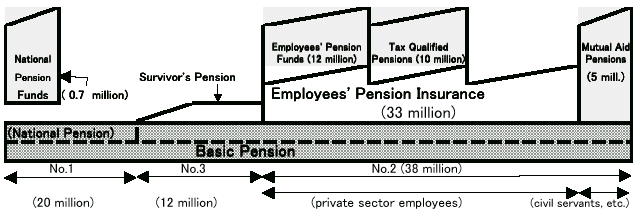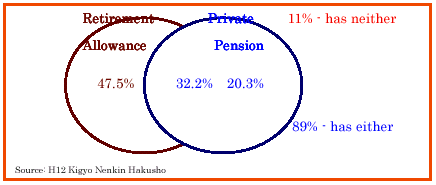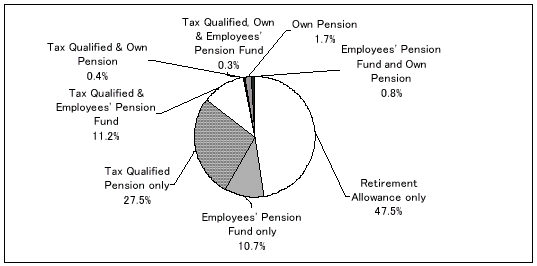
The Japanese pension system is multi-tiered, consisting of public and private pension schemes (Fig.2.1). In this booklet, the distinction between public and private pensions is defined to be whether the insurer of pensions is the government or not. The first tier is the Basic Pension (Kiso Nenkin), which provides the flat rate basic pension of a universal coverage. As a non-income-related pension, it aims to provide a basic income guarantee for the old age, and the participation is mandatory to all residents. The second tier, the Employees' Pension Insurance (Kose Nenkin Hoken) covers the most of employees and provides an income-related payment. It is mandatory to all firms over a certain size, and premium is shared by employers and employees. The first and the second tier pensions are both operated by the government and thus are public. The third tier is an optional scheme. It is provided either by private firms (employers) for their employees, or by collective national pension funds for the self-employed with the government as the insurer. The Employees' Pension Funds is operated by employers, but has a large portion of the Employees' Pension Insurance and thus has a quasi-public character. On top of the three tiers, purely private, individual-based pensions, such as those offered by the life insurance companies, provide the additional coverage for those who wish to purchase the plans.
The schemes in the first and the second tiers for employees are jointly operated and a single contribution rate covers contributions for both schemes. Thus, in many cases, the term "Employees' Pension Insurance" refers to both of them jointly. The Employees' Pension Insurance covers both employees and their spouses (Categories No.2 and No.3. See Fig 2.1).
Similarly, the Basic Pension for the self-employed, farmers and other non-employed (Category No.1) is called the National Pension (Kokumin Nenkin), which are operated, by municipalities (and thus called regional-based pension). The civil servants have a separate scheme on their own called Mutual Aid Pensions, which covers both the Basic Pension portion and the income-related portion. Thus, the entire adult population, in principle, is insured either by the Employees' Pension Insurance, the National Pension or the Mutual Aid Pensions.
Fig 2.1 Pension System

The coverage of the Basic Pension is universal, i.e. it extends to all residents 20 years old or above in Japan including foreigners. For the National Pension, the eligibility to receive pensions requires a minimum of 25 years of premium payment.
3. Mixture of public and private schemes
The insurer of the National Pension and the Employees' Pension Insurance is the government. They form the two pillars of Japan's public pension system. According to a survey, more than 60% of the elderly households entirely depend on the public pension for their income.
Other schemes are occupational pensions. The Employees' Pension Funds, the Tax Qualified Pensions and the Mutual Aid Pensions, the third tier for the Category No.2 insurers (employees), are run by each private firm or the government in the case of the Mutual Aid Pensions where the government is the employer, and not all of the employees are covered by them. The National Pension Funds, which provide the third tier coverage for the Category 1, are run by local and occupational funds. It is also optional, and only a fraction of the Category 1 is participating.
For the Employee's Pension Insurance (the public pension for the Category No.2, i.e. employees), the premium is paid by both employees and employers, and is set at a fixed rate of the salary. The same rate covers the premium for his/her spouse who does not make more than \1.3 million/year (called the No.3 Category). For the National Pension (the public pension for the Category No.1, the self-employed), the premium is paid by the insured only, and is a flat rate for all. Both the Category No.1 and his/her spouse, if he/she is not working as employees, have to pay the premium.
The premium for occupational pensions differs from scheme to scheme, but mostly is paid by the employers for the Category No.2 and by the insured for the Category No.1.
5. Government subsidy for the public pensionsFor the first tier (Basic Pension), one third of the benefits and all of administrative costs are paid from the general budget of the government. This rate is planned to increase to one half by the year 2004. For the second tier (Employees' Pension Insurance) and mutual aid association pensions for central and local civil servants, the administrative costs are paid by the central government. For the third tier, there is no subsidy from the government.
6. Mixed retirement packageJapanese firms traditionally offered to its employees a retirement allowance in the form of a one-time lump-sum payment. Since the introduction of public pension schemes, firms started to offer private pensions to attract employees. Currently, most firms provide a mixture of a lump-sum payment and a pension scheme. Since the two types of scheme are interchangeable in many instances, the entire retirement package is seen as the income security for the retired.
7. Mostly Defined-BenefitThe National Pension, the Employees' Pension Insurance, and other public and occupational schemes are all defined-benefit schemes. However, a law to introduce a Defined-Contribution scheme in the private sector has just passed in 2001, and will be introduced shortly.
As described above, all residents in Japan between ages of 20 to 60 are eligible and required to become a subscriber of the Basic Pension. Whereas employees automatically enroll in the Basic Pension when they subscribe to the Employees' Pension Insurance, the National Pension is for those who are not employees. A fixed amount (\13,300 per month in 2001) is levied on each subscriber as a premium. However, low-income persons (about 19.9% of all No.1subscribers in 1998) and non-working spouses of employees are exempt from paying premiums, partially or entirely. Current benefits are paid out of currently collected premiums (pay-as-you-go system), but as much as one third (to be raised to one half by 2004) of the benefits are subsidized from the general budget of the government. The benefit is flat rate to all, and the scheme is a defined-benefit scheme.
Category 1: All residents who are not Category 2 or 3, i.e. self-employed, farmers, students, etc.
Category 2: All employed persons whose workplace has more than 5 employees
Category 3: Non-working spouses of Category 2
Source: MHW, 2000
Currently, 1.4% of the eligible persons fail to participate in the Basic Pension, and 96% of all persons aged 60 and over receive the Basic Pension, thus its scheme has achieved near perfect universality. The average monthly benefits for the old age are \49,000.
2. The Employees' Pension InsuranceThe Employees' Pension Insurance forms the core of the income security for retirees. All workplaces with more than 5 employees and their employers are required to participate in this scheme. Both employers and employees contribute 8.675% of employee's monthly salary as premiums (including a premium for the National Pension), and the pension benefit is income-related. There is no discount system for low-income persons/household (or his/her employer), but employers of those who are on maternity leave (up to 1 year) are exempt from paying a premium . However, the ceiling of the premium is set at the premium rate multiplied by \620,000 (the maximum category of monthly salary). The benefits are related to the employee's salary. The average monthly benefit for the old age is \177,000, which amounts to 56% of the average monthly salary of subscribers (1999).
3. Corporate pensions and retirement allowance90% of all Japanese firms offer retirement packages for their employees. A retirement package can be either a one-time lump-sum retirement allowance, or a life-long or limited duration pension, or both. In 1997, about a half (52.5%) of firms with some kind of retirement package offered a pension scheme, while nearly 90% provided a lump-sum allowance. Even though the pension is gradually spreading its share, the traditional style of the lump-sum allowance is still the main stream and most employees choose to take a part or the entire amount of the retirement money as the lump-sum payment. Thus, the public pension, private pension and lump-sum retirement allowance, all together make up the total income maintenance support for a retiree.
Fig. 2.3 Share of firms with retirement allowance scheme and/or private pension scheme (1998)

There are three types of corporate pension schemes: 1) the Employees' Pension Fund, 2) the Tax (Exempt) Qualified Pension (scheduled to be phased out in 10 years), and 3) each firm's individual pension scheme. The breakdown of different retirement packages is shown in Fig. 2.4. In addition, a defined-contribution private pension is now under the debate in the Diet, and is likely to pass in near future.
Fig. 2.4 Share of different private pensions by number of firms (1997)

Source: "H11 Kigyo Nenkin Hakusho"
(a) The Employees' Pension FundFirms of more than 500 employees are allowed to set up an Employees' Pension Fund. Currently, about one third (36%) of all employees participate in this scheme. A fund is set up to top off the public pension to ensure a higher level of benefits, and is based on the contributions from both employers and employees of 1.6 to 1.9% each of the employee's salary. The Employees' Pension Insurance and the Employees' Pension Fund are closely related, and some portions of the Insurance are managed by the Fund on its behalf. Thus, even though the Fund is a corporate pension scheme, it has a quasi-public nature and enjoys a tax-favored treatment, but at the same time, is regulated closely by the government.
(b) The Tax (exempt) Qualified PensionAnother type of private pension is the Tax Qualified Pension scheme. Under this scheme, employers are allowed to exempt its contributions from corporate tax. About one third (31%) of all employees are currently participating in this scheme. Compared to the Fund, this scheme is fairly free from regulations of the government, and is the second most popular form of private retirement package next to the lump-sum retirement allowance. Most of the pensions under this scheme are fixed-term (typically 10 years), different from other pensions with a life-long term. Average monthly benefit is \58,499.
However, this scheme is scheduled to be phased out in 10 years.
(c) One-time lump-sum retirement allowanceOne-time lump-sum allowance is still the most preferred form of retirement money, as seen from the fact that 47.5% of total workplaces have only this type of retirement benefits. The benefit level depends on each workplace, but is usually 39 to 46 months worth of monthly salary for employees, who have worked a full-term (38 years for college graduates, and 42 years for high-school graduates).
Aggravated by rapid aging, low rate of economic growth, and near-zero interest rates, the National Pension and the Employees' Pension Insurance are facing a difficulty to secure enough funds to meet the future requirements for pension payments. Various reforms to restrain the payments, including cutting back of future benefits and raising of premiums have taken place in order not to put too much burden on the future generations. Delaying of the pensionable age for the Employees' Pension Insurance from 60 to 65 years old gradually is another example of the reform. In addition, an increase in the government subsidy seems inevitable, but securing financial sources (for example, an increase in the consumption tax) has been politically difficult.
2. Non-compliance and default in the National PensionOne of the biggest problems of the National Pension is that there are a growing number of eligible and required persons who have not become participants or have not paid the premium in full. According to the last official survey (1998), 4.9% of would-be participants of the National Pension have not participated. However, there is no non-compliance in Category No.2, as they automatically become subscribers when they become subscribers of the Employees' Pension Insurance, so that overall non-compliance rate is 1 to 2%.
Even larger problem is the default rate of premiums among the Category No.1 subscribers. In 1998, the ratio of monthly premiums actually paid to fully expected premiums was 76.6%. In addition, 19.9% of the Category No.1 is legally exempt from paying the premium, making the financial situation of the National Pension even worse. Every effort is being made at central, prefectural, and municipal government levels to decrease the default rate. The default and non-compliance of the National Pension is worse in younger generations.
3. Introduction of the defined-contribution schemeIn the private sector, firms are realizing a huge burden of future pension payments, which is now labeled as liabilities under the new accounting system. Together with low-returns on their funds due to the recession of the economy, an interest has been increasing in converting their defined-benefit pension schemes to defined-contribution schemes, in which future payments are related to the investment performance of funds, as opposed to the current system in which future payments are fixed at the beginning. Recently, a new law for the Defined-Contribution corporate pensions has passed and such schemes will be introduced.
4. Changing employment patterns and life cyclesAnother motivation behind the introduction of a defined-contribution pension is the changing employment patterns. The traditional Japanese pattern of a life-long employment has gradually been disintegrating. Thus, firm oriented pension schemes based on a long-term employment at a fixed workplace must be changed to fit the new situation. One of the advantages of the defined-contribution pension, mentioned above, is that it is portable from a firm to another.